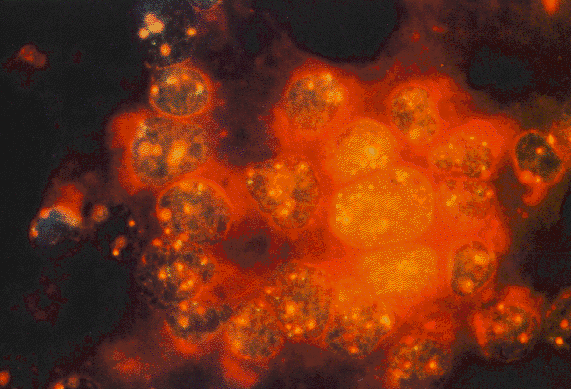
Applying the massive amount of information being generated by the Human Genome Project is an important mission of the Resource for Molecular Cytogenetics. The Resource, a joint effort between LBL and UCSF funded by DOE and private industry, is pioneering improved methods of detecting and studying genetic abnormalities in cancer and other genetic diseases, including those found prenatally and in newborn infants.
An LBL/UCSF team, led by Resource principal investigators Joe Gray and Dan Pinkel and UCSF scientist Fred Waldman, is applying these methods to study genetic changes implicated in breast cancer progression. With support from the Bay Area Breast Cancer Program, the genetic basis for breast cancer is beginning to be understood.
In recent work, a technique called comparative genomic hybridization (CGH) was applied to detect and determine the chromosomal location of genetic aberrations in a large number of breast cancers. Many of the tumors showed loss of material on chromosome 16. Probes to this chromosome obtained from the Los Alamos National Laboratory were used to define the precise region involved on chromosome 16. The gene coding for the cell adhesion molecule E-cadherin was located in the region indicated as being abnormal by these studies. This information, plus evidence from others suggesting that E-cadherin function is frequently lost in advanced cancers, prompted a more detailed investigation of the E-cadherin gene.
First, the investigators, in collaboration with the LBL genome project, isolated a YAC (yeast artificial chromosome) probe for E-cadherin and used this probe to measure the number of copies of the E-cadherin gene in breast cancer cell lines. These studies suggested a strong association between loss of one allele (normal cells have two) of E-cadherin and loss of E-cadherin function. Next, the investigators obtained information about the E-cadherin DNA sequence from the human genome project DNA sequence database and used this information to study the remaining allele. This work showed that the allele was mutated. Thus, loss of E-cadherin function in breast cancer seems to be caused by a physical deletion of one allele and mutation of the other. Loss of function in this gene, which normally produces a protein that binds cells together, may lead to increased ability to invade and metastasize.
The next step is to study E-cadherin in tissue isolated from actual tumors of the breast and other tissues, such as the bladder, ovary and prostate, to determine whether similar mutations and deletions occur there. Identification of E-cadherin mutations and deletions in human cancers may improve prognosis in these cancers, and may further our understanding of how cells escape from their normal location and spread through the body.